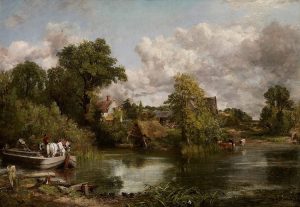Romantic Painter Who Focused on Landscapes

John Constable was an English Romantic painter renowned for his beautiful landscape paintings. With masterpieces like Wivenhoe Park (1816) and The Hay Wain (1821), he revolutionized landscaping as an art genre, and today, his paintings are some of the most valuable in English art.
Constable primarily painted landscapes of Dedham Vale, the region his home was situated in. His paintings of the area reflect his deep affection for the locale, and in an 1821 correspondence with his friend John Fisher, Constable defended his fixation by saying, “I should paint my places best.” The place has now been renamed “Constable Country” after the artist.
John Constable was an adherent of Romanticism, an artistic movement in Europe during the late 18th century characterized by emphasizing emotions and idealism over rationalization and realism. Also, because of its distrust of science and industrialization, Romanticism glorifies the past, mostly Europe’s medieval times. This article looks at the artist and some of his Romantic-style landscape paintings.
BACKGROUND
Painter John Constable was born in East Bergholt, a Suffolk village on the River Stour, on 11 June 1776, the second son born to Golding and Ann Constable. Although Constable was expected to take over the thriving family corn business, he pursued his interest in art.
Constable subsequently enrolled at the Royal Academy Schools, where he received his first formal training in arts. Although his admission was probationary, he strived to hone his talent, and by 1803, he was exhibiting paintings at the Royal Academy.
In 1819, Constable started his famous Six-Footer series, a collection of 6 large-scale landscapes depicting the River Stour. They are considered the defining works of his career. Here are some of John Constable’s paintings.
The White Horse

The White Horse – John Constable
This oil-on-canvas landscape painting is the first in a series that marked a turning point in Constable’s career. It was produced in 1819 and is currently housed at the Frick Collection art museum in New York, USA.
The painting and others in the series depict a scene of the River Stour in Suffolk, England, from its south bank. It shows a white horse being ferried across the river. The surrounding landscape is of the Suffolk countryside where Constable grew up.
The painting was a huge success, earning Constable the position of Associate at the Royal Academy of Arts, London. His dear friend and Bishop of Salisbury, John Fisher, bought the painting for 100 guineas, and it is believed that the purchase gave Constable the financial security to keep painting.
Stratford Mill

The Young Waltonians – Stratford Mill – John Constable
This is an 1820 oil painting from Constable’s six-footer series. The success of The White Horse encouraged Constable to paint another landscape depicting the River Stour, making Stratford Mill the second installment in the series.
The painting portrays the village Stratford St. Mary in Suffolk. Stratford Mill, which the painting is named after, was a water-powered paper mill and can be seen in the left corner of the painting. There is a passenger-carrying ferry on the river, and some children with an adult can be seen fishing on the river bank.
Constable’s friend purchased the painting turned loyal patron John Fisher for 100 guineas. The masterpiece is now housed in the National Gallery in London, while its full-size oil sketch is at the Yale Center for British art, New Haven, USA.
The Hay Wain

Originally titled Landscape: Noon, this painting is arguably Constable’s most famous work and one of Britain’s greatest paintings. It was produced in 1821 and currently resides at the National Gallery in London, England.
The painting depicts yet another scene of the River Stour. Again, we see the river between the Suffolk and Essex counties in this particular one. Three horses pull a large wagon (wain) across the river with Willy Lot’s cottage (the subject of another of Constable’s paintings) visible on the left corner.
In 1824, the painting and some of Constable’s works were exhibited at the Paris Salon. The Hay Wain received much attention and was awarded a gold medal at the exhibition.
The Lock

Dedham Lock and Mill – John Constable
Also in Constable’s six-footer series is this 1824 oil painting. The painting also depicts a scene of rural Suffolk, the River Stour in particular. It was sold at a London auction in July 2012 for £22,441,250.
The scene is set on a cloudy day with a man struggling to open a canal gate at Dedham Lock to allow a lighter barge to continue its journey on the River Stour. The scene also features the Dedham church in the distance.
This painting is the only one in the series in a private collection; the others are located in museums across the world. Constable made a copy of the painting known as the “Foster Version” in 1825. It sold for £9,109,000 at a London auction in 2015.
The Leaping Horse

The Leaping Horse – John Constable
This was Constable’s final installment of the Six-Footers series. The painting currently resides at the Royal Academy in London, while its oil sketch can be found in the Victoria and Albert Museum, London.
The painting depicts the Float Bridge in the River Stour, a wooden bridge and barrier covering a sluice. A barge horse leaps over the erected barrier while a boat sails down the river. Also, a church can be seen in the distance in the right corner of the painting.
Several other details make up the painting, such as rotten planks and bent nails from the bridge. Also in the painting is a net for trapping eels and a passenger with a tiny baby on the boat.
Conclusion
After his death, Constable’s friend and biographer, Charles R. Leslie, described his artistry as “a history of his affections,” suggesting that Constable often painted his affections. This is evident in his attachment to the countryside neighborhood of his childhood, often making it the subject of his paintings. Today, many of his landscapes are scattered across Britain’s most prestigious museums.




